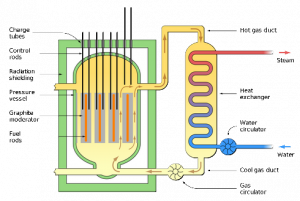Nuclear wasteDealing with irradiated nuclear graphite
Since the beginning of the nuclear power industry, a large number of channel uranium-graphite nuclear power reactors was built across the world. To date, they all are on the output stage of the operation or decommissioning preparation. Approximately 250,000 tons of irradiated graphite are accumulated in the world, including ~ 60,000 tons in Russia. Due to the specificity of irradiated graphite, the treatment of this type of radioactive waste has not been determined yet.

Graphite containers, here used as moderators // Source: wikipedia.org
During the existence of nuclear power industry a large number of channel uranium-graphite nuclear power reactors was built across the world. Russia alone operates four units of the Leningrad Nuclear Power Plant, four units of Kursk NPP, three units of Smolensk NPP, and four units of Bilibino NPP. Also, thirteen industrial uranium-graphite reactors were built (IUGR) have been built. To date, they all are on the output stage of the operation or decommissioning preparation. Approximately 250,000 tons of irradiated graphite are accumulated in the world, including ~ 60,000 tons in Russia. Due to the specificity of irradiated graphite, the treatment of this type of radioactive waste has not been determined yet.
Nuclear economics
At the moment, the problem of irradiated nuclear graphite has been partially solved only for a select group of industrial uranium-graphite reactors. TPU reports that this is possible by referring graphite waste to “special waste”. Thus, in September 2015 it was successfully completed a pilot project to establish a point of long-term preservation of special waste at the site of the industrial uranium-graphite nuclear EI-2 reactor. To implement this project the experts of JSC “PD UGRC” developed and patented the unique technology of IUGR output of operation. For a long time they together with leading institutions (IPCE RAS, NIKIET OKBM, MEPI, VNIINM, Institute of Nuclear Power Plant, and others) have conducted R & D to develop techniques and technical solutions to treat graphite waste.
However, this technology is not applicable for most reactors
“From these reactors it is necessary to extract graphite, then process to remove the most active radionuclides. Therefore, it is required to develop technologies, devices and hardware systems to reduce radioactive waste activity, which will make disposal of graphite economically profitable,” explains Evgeniy Bespala, a Ph.D. student from the Department of Technical Physics. Disposal of different classes of waste has a different price: the price for disposal of high-level, intermediate-level, and low-level waste differs enormously. If we reduce the amount of radioactive nuclides in reactor graphite, the cost of its disposal will be economically feasible.
Now scientists from different countries are searching for methods for reprocessing irradiated nuclear graphite. There are different ways: from pyrolytic incineration to centrifugation. Which one is the best is still unknown.
Bespala has been addressing the issue of nuclear graphite reprocessing for more than five years. Currently, he is an R & D engineer at JSC “Pilot and Demonstration Center for Uranium-Graphite Reactors Decommissioning” (the city of Seversk, Russia). Last year, the polytechnicer became one of the winners of the UMNIK program and received financial support to perform his research.
Approaches for reducing graphite activity
The technology proposed by the polytechnicer implies the heating of reactor graphite in a low-temperature plasma to more than three thousand degrees by Celsius. As a result, graphite and radionuclides contained therein sublimate. Further there is a stepwise deposition of substances in a special plasma-chemical reactor. To create such a reactor is a task before the scientist.
Carbon and radionuclides evaporate together, they are separated one from another in steps in different parts of plasma chemical reactor due to the difference in physicochemical properties. Thus, radioactive nuclei are selectively extracted from graphite. Therefore, carbon black, which is formed by plasma-chemical reactions within the plasma chamber, is getting less active, says Evgeniy Bespala.
According to the polytechnicer the technology itself is not new: previously radioactive waste has been processed in plasma. However, this was low-level metal waste.
Within the UMNIK grant, researchers will deal with creating a facility that provides mass graphite processing without human intervention. This will allow automating the entire process and protecting people from hazardous radioactive sources. According to the plan, irradiated nuclear graphite will be loading to the facility only and then carbon waste with less activity compared to the original will be removed, - says the polytechnicer.
Tomsk scientists and Seversk colleagues already are testing their technologies. The Department of technical physics at Tomsk Polytechnic University conducts required experiments for graphite evaporation in low-temperature plasma. All radiation research, in turn, is held in Seversk, as there is an opportunity to follow all the rules of radiation safety. For the present, the technology has been tested on mixtures of carbon stable isotopes. TPU noes that Next year, the scientists plan to test their facility on irradiated reactor graphite.
— Read more in E V Bespala et al., “Analysis of Wigner energy release process in graphite stack of shut-down uranium-graphite reactor,” IOP Conference Series: Materials Science and Engineering (2015): 012065 (DOI: 10.1088/1757-899X/93/1/012065)
